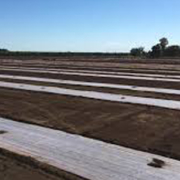Research Adds Details on Tarping for Weed Control
Research conducted by Virginia Cooperative Extension with funding from Southern SARE tested the amount of time required to kill a variety of annual and perennial weeds with a light-blocking silage tarp. Trials that used light-blocking silage tarps over a 16-week period revealed that some weed species took longer than others to die under cover, but the study found that perennial weeds can be killed in half of the growing season, allowing producers to use the ground for either production or cover cropping during the second half of the season. Virginia Cooperative Extension released a factsheet that highlights results of the project for more than 30 weed species, Tarping and Occultation Techniques in Gardening and Farming.
Related ATTRA publication: Soil Solarization and Biosolarization



 (USDA/FPAC photo by Preston Keres)
(USDA/FPAC photo by Preston Keres)